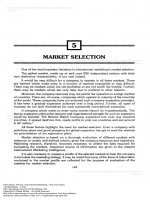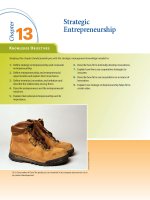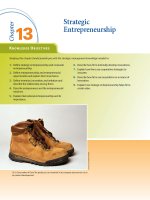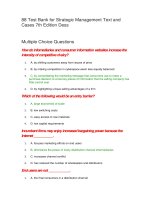Strategic retail management text and international cases joachim zentes
Bạn đang xem bản rút gọn của tài liệu. Xem và tải ngay bản đầy đủ của tài liệu tại đây (8.02 MB, 358 trang )
Joachim Zentes | Dirk Morschett | Hanna Schramm-Klein
Strategic Retail Management
Joachim Zentes | Dirk Morschett |
Hanna Schramm-Klein
Strategic Retail
Management
Text and International Cases
Bibliographic information published by Die Deutsche Nationalbibliothek
Die Deutsche Nationalbibliothek lists this publication in the Deutsche Nationalbibliografie;
detailed bibliographic data is available in the Internet at <>.
Joachim Zentes () is Professor of Marketing and Management at the
Saarland University, Saarbrücken, Germany. He is Director of the Institute for Commerce & International Marketing (H.I.MA.) and Director of the Europa-Institut at Saarland University. He holds a
chair in Business Adminstration, with a focus on Foreign Trade and International Management.
Joachim Zentes is also a member of various boards of directors and advisory boards in Germany and
abroad.
Dirk Morschett (D. ) is Assistant Professor of Marketing and Management at the Institute for Commerce & International Marketing (H.I.MA.), Saarland University, Saarbrücken.
Hanna Schramm-Klein () is Assistant Professor of Marketing and
Management at the Institute for Commerce & International Marketing (H.I.MA.), Saarland University, Saarbrücken.
1st edition February 2007
All rights reserved
© Betriebswirtschaftlicher Verlag Dr. Th. Gabler | GWV Fachverlage GmbH, Wiesbaden 2007
Gabler is a company of Springer Science+Business Media.
www.gabler.de
No part of this publication may be reproduced, stored in a retrieval system or
transmitted, mechanical, photocopying or otherwise without prior permission of
the copyright holder.
Registered and/or industrial names, trade names, trade descriptions etc. cited in this publication
are part of the law for trade-mark protection and may not be used free in any form or by any
means even if this is not specifically marked.
Cover design: Ulrike Weigel, www.CorporateDesignGroup.de
Printing and binding: Wilhelm & Adam, Heusenstamm
Printed on acid-free paper
Printed in Germany
ISBN 978-3-8349-0287-0
Preface
Retailingȱ isȱ becomingȱ consistentlyȱ moreȱ importantȱ inȱ economicȱ terms.ȱ Thisȱ
becomesȱ evidentȱ whenȱ lookingȱ atȱ theȱ developmentȱ ofȱ manyȱ individualȱ
countries,ȱ inȱ Europe,ȱAmericaȱ andȱAsia.ȱ Inȱ highlyȱ developedȱ countries,ȱ reȬ
tailingȱ isȱ assumingȱ moreȱ andȱ moreȱ ofȱ aȱ leadershipȱ roleȱ inȱ theȱ distributionȱ
channel.ȱ Theȱ expansionȱ strategies,ȱ retailȱ brandingȱ strategies,ȱ innovativeȱ
solutionsȱ forȱ supplyȱ chainȱ managementȱ etc.,ȱ allȱ reflectȱ thisȱ trend.ȱ Inȱ transȬ
formationȱ countries,ȱ suchȱ asȱ inȱ Centralȱ andȱ Easternȱ Europe,ȱ asȱ wellȱ asȱ inȱ
emergingȱcountries,ȱsuchȱasȱChinaȱandȱIndia,ȱfundamentalȱchangesȱinȱretailȬ
ingȱstructuresȱbecomeȱapparentȱandȱmayȱleadȱtoȱcomparableȱdevelopments.ȱ
Inȱ viewȱ ofȱ internationalisation,ȱ aȱ furtherȱ profoundȱ changeȱ canȱ beȱ noticed.ȱ
Retailingȱcompaniesȱthatȱwereȱformerlyȱcharacterisedȱbyȱaȱlocalȱorȱnationalȱ
orientationȱareȱincreasinglyȱdevelopingȱintoȱglobalȱplayersȱ withȱworldwideȱ
operations.ȱ
Book Concept and Overview
Theȱ presentȱ bookȱ isȱ devotedȱ toȱ theȱ dynamicȱ developmentȱ ofȱ retailing.ȱ Theȱ
variousȱ strategyȱ conceptsȱ adoptedȱ byȱ retailingȱ companiesȱ andȱ theirȱ impleȬ
mentationȱ inȱ practiceȱ areȱ atȱ theȱ coreȱ ofȱ theȱ book.ȱ Thisȱ isȱ notȱ aȱ traditionalȱ
textbookȱ orȱ collectionȱ ofȱ caseȱ studies,ȱ butȱ isȱ intendedȱ toȱ demonstrateȱ theȱ
complexȱ andȱ manifoldȱ questionsȱ ofȱ retailȱ managementȱ inȱ theȱ formȱ ofȱ 15ȱ
lessonsȱthatȱprovideȱaȱthematicȱoverviewȱofȱkeyȱissuesȱandȱtoȱillustrateȱthemȱ
withȱ theȱ helpȱ ofȱ comprehensiveȱ caseȱ studies.ȱ Internationallyȱ knownȱ retailȱ
companiesȱ areȱ usedȱ asȱ examplesȱ toȱ facilitateȱ anȱ understandingȱ ofȱ whatȱ isȱ
involvedȱinȱstrategicȱretailȱmanagementȱandȱtoȱpresentȱsomeȱbestȱpractices.ȱȱ
Theȱ bookȱ isȱ dividedȱ intoȱ fourȱ mainȱ parts.ȱ Partȱ Iȱ introducesȱ “Formatsȱ andȱ
PlayersȱinȱRetailing”ȱandȱcomprisesȱChaptersȱ1ȱtoȱ3.ȱInȱPartȱII,ȱgrowth,ȱinterȬ
nationalisationȱ andȱ positioningȱ strategies,ȱ asȱ fundamentalȱ aspectsȱ ofȱ “StraȬ
tegicȱMarketingȱinȱRetailing”ȱareȱdealtȱwithȱ(Chapterȱ4ȱtoȱChapterȱ6).ȱPartȱIIIȱ
focusesȱ onȱ theȱ “Marketingȱ Mixȱ inȱ Retailing”.ȱ Storeȱ location,ȱ merchandiseȱ
andȱ categoryȱ management,ȱ pricing,ȱ instoreȱ marketingȱ andȱ customerȱ relaȬ
tionshipȱ managementȱ areȱ discussedȱ inȱ Chaptersȱ 7ȱ toȱ 11.ȱ Theȱ finalȱ Partȱ IVȱ
“Buying,ȱ Logisticsȱ andȱ Performanceȱ Measurement”ȱ dealsȱ withȱ retailȱ purȬ
chasingȱ strategiesȱ andȱ concepts,ȱ modernȱ conceptsȱ ofȱ physicalȱ distributionȱ
andȱITȬbasedȱsupplyȱchainȱmanagement,ȱasȱwellȱasȱmethodsȱofȱperformanceȱ
andȱfinancialȱcontrollingȱ(Chaptersȱ12ȱtoȱ15).ȱ
V
Preface
Teaching and Learning
Theȱbookȱisȱtargetedȱprimarilyȱatȱstudentsȱinȱtheirȱthirdȱandȱfourthȱacademicȱ
yearȱ(undergraduateȱandȱgraduateȱlevel)ȱinȱtheȱfieldȱofȱBusinessȱAdministraȬ
tion/Marketing/Managementȱ atȱ differentȱ institutions,ȱ suchȱ asȱ universities,ȱ
academiesȱ andȱ businessȱ schools.ȱ Inȱ addition,ȱ practitionersȱ inȱ theȱ consumerȱ
goodsȱindustryȱandȱinȱretailingȱcompanies,ȱwhoȱwishȱtoȱobtainȱcompactȱandȱ
practiceȬorientedȱ informationȱ onȱ currentȱ retailȱ concepts,ȱ willȱ alsoȱ benefitȱ
fromȱreadingȱthisȱbook.ȱ
Furthermore,ȱtheȱbookȱcanȱbeȱusedȱinȱeducationȱasȱaȱbasisȱforȱworkingȱwithȱ
caseȱstudies.ȱForȱthisȱpurpose,ȱtheȱcaseȱstudiesȱareȱintegratedȱintoȱtheȱlessonsȱ
inȱsuchȱaȱwayȱthatȱtheyȱprovideȱadditionalȱcontentȱandȱaȱspecificȱapplicationȱ
ofȱtheȱindividualȱlessons.ȱThatȱis,ȱtheyȱformȱpartȱofȱtheȱmainȱtopic,ȱbutȱalsoȱ
leadȱ toȱ suggestedȱ discussionȱ subjectsȱ andȱ questionsȱ inȱ orderȱ toȱ deepenȱ theȱ
understandingȱ ofȱ theȱ topic.ȱ Instructorsȱ areȱ providedȱ withȱ additionalȱ reȬ
sources.ȱForȱeachȱcaseȱstudy,ȱaȱsuggestedȱsolutionȱcanȱbeȱrequestedȱfromȱtheȱ
H.I.MA.ȱ (Instituteȱ forȱ Commerceȱ &ȱ Internationalȱ Marketing,ȱ Saarlandȱ UniȬ
versity,ȱGermany,ȱeȬmail:ȱȬsaarland.de).ȱ
Acknowledgements
Aȱ caseȱ studyȱ approachȱ cannotȱ beȱ developedȱ effectivelyȱ withoutȱ theȱ activeȱ
supportȱ andȱ cooperationȱ ofȱ theȱ selectedȱ retailingȱ companies.ȱ Thus,ȱ weȱ firstȱ
ofȱ allȱ thankȱ theȱ companiesȱ andȱ theirȱ representativesȱ whoȱ haveȱ willinglyȱ
supportedȱusȱinȱtheȱdevelopmentȱofȱtheȱcaseȱstudies.ȱ
Atȱ Gablerȱ Verlag,ȱ Barbaraȱ Roscherȱ supervisedȱ ourȱ bookȱ conceptȱ fromȱ theȱ
beginningȱandȱweȱareȱindebtedȱtoȱherȱforȱherȱsupport.ȱ
Atȱ theȱ H.I.MA.,ȱ whereȱ theȱ threeȱ authorsȱ teachȱ andȱ researchȱ retailȱ manageȬ
ment,ȱ weȱ wouldȱ particularlyȱ likeȱ toȱ thankȱ Julianeȱ Krebsȱ forȱ preparingȱ aȱ
numberȱofȱcaseȱstudiesȱinȱcooperationȱwithȱtheȱretailȱcompanies,ȱasȱwellȱasȱ
forȱtheȱlayoutȱ designȱandȱfinalȱediting.ȱCaseȱstudiesȱwereȱalsoȱpreparedȱbyȱ
MarkusȱLehnert,ȱSandraȱPocsayȱandȱLambertȱScheer.ȱȱ
Finally,ȱ thanksȱ goȱ toȱ Brianȱ Blochȱ andȱ Heikeȱ Frenschȱ forȱ supportȱ withȱ theȱ
translationȱ ofȱ partsȱ ofȱ theȱ manuscriptȱ andȱ theȱ proofreading.ȱ Heikeȱ Frenschȱ
hasȱ typedȱ severalȱ versionsȱ ofȱ theȱ scriptȱ withȱ greatȱ accuracyȱ andȱ commitȬ
ment.ȱ
Saarbrücken,ȱJanuaryȱ2007ȱ
ȱ
JOACHIMȱZENTESȱ
VI
ȱȱȱȱȱȱȱȱȱȱȱȱȱȱȱȱȱȱȱȱDIRKȱMORSCHETTȱ ȱȱȱȱȱȱȱȱȱȱȱȱȱȱȱȱȱȱHANNAȱ SCHRAMMȬKLEIN
Contents
Prefaceȱ
Introductionȱ
................................................................................................... Vȱ
................................................................................................... ȱ1ȱ
Part I
Formats and Players in Retailing
Chapterȱ1ȱ
RetailȱFormatsȱ–ȱFood.............................................................. 9ȱ
CaseȱStudy:ȱCarrefour .............................................................. 20ȱ
Chapterȱ2ȱ
RetailȱFormatsȱ–ȱNonȬFood................................................... 31ȱ
CaseȱStudy:ȱMediaȱMarktȱandȱSaturnȱ..................................... 42ȱ
Chapterȱ3ȱ
NewȱCompetitorsȱ–ȱVerticalȱStrategies…………………….53ȱ
CaseȱStudy:ȱEsprit .................................................................... 62ȱ
Part II
Strategic Marketing in Retailing
Chapterȱ4ȱ
GrowthȱStrategies .................................................................. 77ȱ
CaseȱStudy:ȱFressnapf/MaxiȱZoo.............................................. 88ȱ
Chapterȱ5ȱ
TheȱInternationalisationȱofȱRetailing ................................. 101ȱ
CaseȱStudy:ȱAldi ..................................................................... 109ȱ
Chapterȱ6ȱ
RetailȱBrandingȱandȱPositioning ........................................ 121ȱ
CaseȱStudy:ȱIKEA ................................................................... 130ȱ
Part III
Marketing Mix in Retailing
Chapterȱ7ȱ
ȱ
StoreȱLocationȱ–ȱTradingȱAreaȱAnalysisȱandȱSiteȱȱ
Selection ................................................................................ 143ȱ
CaseȱStudy:ȱECEȱProjektmanagement.................................... 154ȱ
Chapterȱ8ȱ
MerchandiseȱandȱCategoryȱManagement......................... 163ȱ
CaseȱStudy:ȱCoopȱ(Switzerland) ............................................. 174ȱ
ȱ
ȱ
VII
Brief Contents
Chapterȱ9ȱ
Pricing ....................................................................................187ȱ
CaseȱStudy:ȱWalȬMart.............................................................198ȱ
Chapterȱ10ȱ
InstoreȱMarketing .................................................................209ȱ
CaseȱStudy:ȱGaleriesȱLafayette ................................................220ȱ
Chapterȱ11ȱ
CustomerȱRelationshipȱManagement ................................231ȱ
CaseȱStudy:ȱTesco ....................................................................243ȱ
Part IV
Buying, Logistics and Performance Measurement
Chapterȱ12ȱ
Buyingȱ–ȱStrategyȱandȱConcepts.........................................255ȱ
CaseȱStudy:ȱKingfisher ............................................................266ȱ
Chapterȱ13ȱ
Logisticsȱ–ȱPhysicalȱDistribution ........................................277ȱ
CaseȱStudy:ȱSainsbury’s..........................................................286ȱ
Chapterȱ14ȱ
ȱ
Logisticsȱ–ȱSupplyȱChainȱManagementȱandȱȱ
InformationȱManagement....................................................297ȱ
CaseȱStudy:ȱBenetton ..............................................................308ȱ
Chapterȱ15ȱ
ControllingȱandȱFinancialȱManagement ............................317ȱ
CaseȱStudy:ȱMetro...................................................................325ȱ
ȱ
Referencesȱ
Indexȱ
ȱ
VIII
.................................................................................................337ȱ
.................................................................................................363ȱ
Introduction
Introduction
Retailingȱisȱoneȱofȱtheȱworld’sȱlargestȱindustries.ȱItȱisȱinȱaȱpermanentȱstateȱofȱ
change,ȱandȱtheȱpaceȱofȱthisȱchangeȱhasȱbeenȱacceleratingȱoverȱtheȱlastȱdecȬ
ade.ȱFromȱtheȱmarketingȱperspective,ȱretailersȱare,ȱbyȱdefinition,ȱcloserȱtoȱtheȱ
consumerȱ thanȱ manufacturingȱ companiesȱ (Reynoldsȱ 2004b,ȱ p.ȱ 3).ȱ Retailersȱ
representȱ theȱ culminationȱ ofȱ theȱ marketingȱ processȱ andȱ theȱ contactȱ pointȱ
betweenȱconsumersȱandȱmanufacturedȱproducts.ȱWhileȱretailingȱhasȱlongȱsetȱ
buyingȱdecisionsȱasȱitsȱhighestȱpriorityȱandȱwasȱveryȱfocussedȱonȱtheȱprodȬ
uctȱassortment,ȱitȱnowȱfollowsȱaȱmoreȱholisticȱapproachȱtoȱmanagementȱandȱ
marketingȱandȱisȱseizingȱtheȱopportunityȱtoȱbeȱconsumerȬoriented,ȱengageȱinȱ
theȱ personalȱ contactȱ withȱ customers,ȱ gatherȱ informationȱ onȱ consumerȱ beȬ
haviourȱandȱexploitȱinsightsȱintoȱconsumerȱbehaviourȱandȱpreferences.ȱWhatȱ
wasȱ onceȱ aȱ simpleȱ wayȱ ofȱ doingȱ businessȱ isȱ transformingȱ intoȱ aȱ highlyȱ soȬ
phisticatedȱ formȱ ofȱ managementȱ andȱ marketing.ȱ Retailȱ marketingȱ consisȬ
tentlyȱ featuresȱ moreȱ efficient,ȱ moreȱ meaningfulȱ andȱ moreȱ profitableȱ marȬ
ketingȱpracticesȱ(Mulhernȱ1997,ȱp.ȱ103).ȱ
Evolutionȱofȱ
Retailȱȱ
Managementȱ
Retailingȱinvolvesȱthoseȱcompaniesȱthatȱareȱengagedȱprimarilyȱinȱtheȱactivityȱ
ofȱ purchasingȱ productsȱ fromȱ otherȱ organisationsȱ withȱ theȱ intentȱ toȱ resellȱ
thoseȱ goodsȱ toȱ theȱ finalȱ customer,ȱ generallyȱ withoutȱ transformation,ȱ andȱ
renderingȱservicesȱincidentalȱtoȱtheȱsaleȱofȱmerchandise.ȱTheȱretailingȱprocȬ
essȱisȱtheȱfinalȱstepȱinȱtheȱdistributionȱofȱmerchandise;ȱretailersȱareȱthereforeȱ
organisedȱtoȱsellȱmerchandiseȱinȱsmallȱquantitiesȱtoȱtheȱgeneralȱpublic.ȱTheȱ
servicesȱaddedȱtoȱtheȱproductsȱcommonlyȱincludeȱtransportationȱandȱstockȬ
keepingȱtoȱensureȱthatȱtheȱproductsȱareȱavailableȱatȱtheȱpointȬofȬsale.ȱHowȬ
ever,ȱ theȱ processȱ alsoȱ encompassesȱ theȱ selectionȱ ofȱ productsȱ forȱ aȱ retailȱ asȬ
sortment,ȱ theȱ provisionȱ ofȱ salesȱ advice,ȱ afterȬsalesȬserviceȱ andȱ manyȱ otherȱ
functions.ȱ
Definitionȱ
ofȱRetailingȱ
AȱnumberȱofȱdevelopmentsȱareȱresponsibleȱforȱtheȱdynamicȱchangeȱinȱmodȬ
ernȱ retailȱ management.ȱ Inȱ mostȱ developedȱ countries,ȱ retailingȱ hasȱ experiȬ
encedȱaȱdramaticȱincreaseȱinȱtheȱscaleȱofȱoperationsȱandȱinȱmarketȱconcentraȬ
tion.ȱThisȱisȱdueȱpartlyȱtoȱtheȱappearanceȱofȱlargeȬscaleȱretailȱchainsȱthatȱhaveȱ
takenȱ overȱ marketȱ shareȱ fromȱ independentlyȱ ownedȱ smallȱ shops.ȱ Theseȱ
retailȱ chainsȱ firstȱ developedȱ intoȱ regionalȱ groupsȱ andȱ thenȱ intoȱ nationallyȱ
andȱevenȱinternationallyȱactiveȱretailȱoperations.ȱInȱtheȱlastȱdecade,ȱmergersȱ
andȱ acquisitionsȱ betweenȱ alreadyȱ largeȱ playersȱ haveȱ intensifiedȱ thisȱ develȬ
opment.ȱManyȱretailersȱnowȱhaveȱmassiveȱturnover,ȱveryȱlargeȱnumbersȱ ofȱ
employeesȱ andȱ extensiveȱ storeȱ networks.ȱ Theȱ world’sȱ largestȱ retailer,ȱ WalȬ
Emergenceȱofȱȱ
LargeȬScaleȱȱ
RetailȱChainsȱ
1
Introduction
Mart,ȱachievesȱaȱturnoverȱofȱ312ȱbillionȱUSDȱwhichȱexceedsȱtheȱgrossȱdomesȬ
ticȱproductȱofȱmanyȱsmallerȱcountriesȱandȱemploysȱ1.8ȱmillionȱpeople.ȱCarreȬ
four,ȱtheȱlargestȱEuropeanȱretailerȱandȱtheȱno.ȱ2ȱinȱtheȱworld,ȱoperatesȱmoreȱ
thanȱ12,000ȱstoresȱworldwide.ȱ
Internationalȱ
MultiȬChannelȱ
Retailersȱ
Atȱ theȱ sameȱ time,ȱ manyȱ retailersȱ haveȱ developedȱ intoȱ internationalȱ multiȬ
channelȱretailers,ȱthatȱis,ȱtheyȱoperateȱinȱmanyȱcountriesȱandȱofferȱdifferentȱ
retailȱformatsȱforȱtheirȱcustomers.ȱForȱexample,ȱtheȱFrenchȱCarrefourȱisȱnowȱaȱ
multiȬformatȱ groupȱ thatȱ usesȱ hypermarkets,ȱ supermarkets,ȱ convenienceȱ
stores,ȱhardȱdiscountersȱandȱotherȱformatsȱtoȱsellȱitsȱassortmentȱtoȱcustomersȱ
inȱ overȱ 30ȱ countries.ȱ Moreȱ thanȱ halfȱ ofȱ itsȱ turnoverȱ isȱ earnedȱ outsideȱ theȱ
homeȱ market.ȱ Theȱ Germanȱ Metroȱ Groupȱ employsȱ foodȱ superstoresȱ (Real),ȱ
foodȱ supermarketsȱ (extra),ȱ consumerȱ electronicsȱ categoryȱ killersȱ (Mediaȱ
Marktȱ andȱ Saturn),ȱ cashȱ &ȱ carryȱ wholesaleȱ storesȱ (Metroȱ C&C),ȱ andȱ otherȱ
formatsȱ andȱ earnsȱ moreȱ thanȱ 50ȱ %ȱ ofȱ itsȱ turnoverȱ inȱ 29ȱ marketsȱ outsideȱ
Germany.ȱTescoȱisȱexpandingȱrapidlyȱintoȱEasternȱEuropeanȱandȱAsianȱmarȬ
ketsȱand,ȱinȱadditionȱtoȱseveralȱstoreȬbasedȱformats,ȱveryȱsuccessfullyȱoperȬ
atesȱ anȱ eȬcommerceȱ channel,ȱ Tesco.com.ȱ Whileȱ theȱ riseȱ ofȱ eȬcommerceȱ inȱ reȬ
tailingȱwasȱinitiallyȱoverȬestimatedȱinȱtheȱdaysȱofȱInternetȱhype,ȱitȱhasȱnoneȬ
thelessȱ developedȱ slowlyȱ butȱ surelyȱ andȱ Tescoȱ nowȱ achievesȱ salesȱ ofȱ overȱ
1ȱbillionȱEURȱwithȱitsȱonlineȬchannel.ȱ
HighȱLevelsȱ
ofȱConcentrationȱ
Inȱmostȱcountryȱmarkets,ȱretailingȱisȱalsoȱaȱveryȱconcentratedȱindustry.ȱAcȬ
cordingȱtoȱtheȱmarketȱresearchȱcompanyȱPlanetȱRetail,ȱtheȱtopȱ5ȱfoodȱretailersȱ
accountȱ forȱ moreȱ thanȱ 55ȱ %ȱ ofȱ theȱ marketȱ inȱ theȱ UKȱ Inȱ Germanyȱ andȱ inȱ
France,ȱitȱisȱevenȱaboveȱ70ȱ%.ȱConsequently,ȱaȱshiftȱinȱpowerȱwithinȱtheȱdistriȬ
butionȱ channelȱ isȱ oneȱ ofȱ theȱ mostȱ influentialȱ developmentsȱ overȱ theȱ lastȱ
decades.ȱ Theȱ powerȱ ofȱ individualȱ retailȱ organisationsȱ isȱ growing;ȱ theyȱ areȱ
nowȱcomparableȱtoȱand,ȱinȱmanyȱcases,ȱevenȱlargerȱthanȱmanyȱmanufacturȬ
ers,ȱ evenȱ forȱ globalȱ brandȱ manufacturersȱ suchȱ asȱ Procterȱ &ȱ Gamble,ȱ Sonyȱ orȱ
Nestlé.ȱThus,ȱmanufacturersȱ nowȱdependȱonȱaȱfewȱlargeȱretailersȱforȱaȱsubȬ
stantialȱshareȱofȱtheirȱturnover.ȱHandȱinȱhandȱwithȱtheȱincreasingȱsize,ȱretailȱ
marketingȱ budgets,ȱ ITȱ budgets,ȱ andȱ budgetsȱ forȱ topȱ managers,ȱ haveȱ beenȱ
increasing.ȱ Notȱ onlyȱ theȱ growingȱ sizeȱ andȱ concentration,ȱ butȱ alsoȱ theȱ inȬ
creasedȱsophisticationȱofȱretailȱmanagement,ȱcombinedȱwithȱtheȱbetterȱavailȬ
abilityȱofȱcustomerȱdata,ȱcontributedȱtoȱtheȱpowerȱshift.ȱRetailingȱisȱcurrentlyȱ
oneȱofȱtheȱleadingȱindustriesȱinȱtheȱapplicationȱofȱnewȱtechnologies.ȱRetailerȱ
PoSȱdataȱhasȱbecameȱmoreȱvaluableȱasȱITȱsystemsȱhaveȱfacilitatedȱtheȱcollecȬ
tionȱ ofȱ dataȱ atȱtheȱ checkout.ȱ Furthermore,ȱ asȱ retailersȱ haveȱ grownȱ fromȱ reȬ
gionalȱ toȱ nationalȱ chains,ȱ theyȱ haveȱ beenȱ ableȱ toȱ accumulateȱ knowledgeȱ
aboutȱ consumerȱ trends,ȱ theȱ developmentȱ ofȱ productȱ sales,ȱ etc.,ȱ thatȱ hasȱ
enhancedȱ theirȱ relevanceȱ asȱ gatekeepersȱ forȱ productsȱ onȱ theirȱ routeȱ toȱ theȱ
customer.ȱCustomerȬspecificȱdataȱthatȱisȱnowȱincreasinglyȱbeingȱgatheredȱviaȱ
loyaltyȱcards,ȱaddsȱtoȱthisȱknowledge.ȱWhereȱmanufacturerȱbrandsȱonceȱusedȱ
ȱ
PowerȱShiftȱ
towardsȱȱ
Retailersȱ
2
Introduction
toȱ beȱ allȱ important,ȱ theȱ lastȱ fewȱ yearsȱ haveȱ witnessedȱ theȱ powerȱ ofȱ retailȱ
brandsȱ challengingȱ theȱ positionȱ ofȱ suppliersȱ (Gilbertȱ 2003,ȱ p.ȱ1).ȱ Retailersȱ
haveȱstartedȱtoȱembraceȱtheȱconceptȱofȱstrategicȱmarketing,ȱtheyȱuseȱstrategicȱ
planningȱ andȱ positionȱ themselvesȱ relativeȱ toȱ theirȱ competitors.ȱ Thus,ȱ theȱ
enormousȱ buyingȱ volumeȱ ofȱ retailersȱ isȱ onlyȱ oneȱ sourceȱ ofȱ itsȱ powerȱ base,ȱ
certainlyȱtheȱmostȱimportant,ȱbutȱotherȱdevelopmentsȱaddȱtoȱtheirȱpower.ȱ
Retailersȱareȱintermediariesȱinȱtheȱdistributionȱchannel.ȱHowever,ȱwhileȱretailȬ
ingȱ hasȱ longȱ beenȱ consideredȱ aȱ somewhatȱ passiveȱ linkȱ inȱ theȱ valueȱ chainȱ
betweenȱ manufacturerȱ andȱ consumer,ȱ retailersȱ nowȱ useȱ theirȱ positionȱ toȱ
becomeȱtheȱdominantȱplayerȱinȱtheȱdistributionȱchannel.ȱTheyȱdevelopȱtheirȱownȱ
marketingȱ conceptsȱ andȱ assumeȱ marketingȱ leadershipȱ inȱ theȱ verticalȱ relationȬ
shipȱ withȱ manufacturers.ȱ Retailersȱ haveȱ alsoȱ developedȱ theirȱ ownȱ logisticsȱ
concepts.ȱ Accordingly,ȱ whileȱ itȱ wasȱ theȱ manufacturersȱ whoȱ traditionallyȱ
fulfilledȱ largeȱ partsȱ ofȱ theȱ logisticsȱ function,ȱ retailersȱ todayȱ alsoȱ striveȱ toȬ
wardsȱlogisticsȱleadershipȱinȱtheȱdistributionȱchannel.ȱ
Marketingȱandȱ
LogisticsȱLeaderȬ
shipȱ
Withȱthisȱbook,ȱourȱobjectiveȱisȱtoȱcoverȱtheȱmostȱimportantȱaspectsȱofȱretailȱ
managementȱwithȱaȱcomprehensive,ȱyetȱbrief,ȱandȱinnovativeȱapproach.ȱWeȱ
discussȱ 15ȱ differentȱ topicsȱ inȱ retailȱ managementȱ byȱ firstȱ givingȱ aȱ thematicȱ
overviewȱ ofȱ theȱ topicȱ whichȱ coversȱ theȱ keyȱ issuesȱ andȱ explainsȱ theȱ mostȱ
importantȱ conceptsȱ andȱ thenȱ illustratingȱ themȱ withȱ theȱ helpȱ ofȱ extendedȱ
caseȱ studies.ȱ Forȱ theȱ caseȱ studies,ȱ internationallyȱ knownȱ companiesȱ wereȱ
chosenȱ thatȱ canȱ beȱ consideredȱ bestȱ practiceȱ casesȱ inȱ theȱ respectiveȱ strategyȱ
fields.ȱ
InȱPartȱI,ȱformatsȱandȱplayersȱinȱretailingȱareȱdiscussed.ȱAȱretailȱformatȱrepreȬ
sentsȱ aȱ specificȱ configurationȱ ofȱ theȱ retailȱ marketingȱ mixȱ (e.g.ȱ storeȱ size,ȱ
typicalȱ location,ȱ merchandise,ȱ priceȱ andȱ serviceȱ offered)ȱ andȱ itȱ oftenȱ formsȱ
theȱcoreȱofȱtheȱretailȱstrategy.ȱDifferentȱformatsȱareȱdescribedȱandȱthereȱisȱaȱ
discussionȱ ofȱ thoseȱ thatȱ areȱ currentlyȱ gainingȱ marketȱ shareȱ andȱ thoseȱ forȬ
matsȱ thatȱ areȱ onȱ theȱ decline.ȱ Forȱ example,ȱ categoryȱ killersȱ suchȱ asȱ IKEA,ȱ
MediaȱMarktȱandȱLeroyȱMerlinȱhaveȱbeenȱgrowingȱtremendouslyȱoverȱtheȱlastȱ
fewȱ decades.ȱ Hardȱ discounters,ȱ suchȱ asȱ Aldi,ȱ areȱ certainlyȱ oneȱ ofȱ theȱ mostȱ
aggressivelyȱgrowingȱretailȱformatsȱinȱfoodȱretailingȱworldwide,ȱandȱeȬcomȬ
merceȱisȱgrowingȱconstantlyȱfromȱaȱstillȱratherȱsmallȱbase.ȱSomeȱpureȱInterȬ
netȱplayers,ȱsuchȱasȱAmazonȱandȱDell,ȱhaveȱreachedȱaȱveryȱconsiderableȱscale,ȱ
butȱ Internetȱ shoppingȱ isȱ offeredȱ moreȱ andȱ moreȱ oftenȱ asȱ partȱ ofȱ aȱ multiȬ
channelȱ approachȱ (Chaptersȱ 1ȱ andȱ 2).ȱAtȱ theȱ sameȱ time,ȱ notȱ onlyȱ newȱ forȬ
mats,ȱ butȱ alsoȱ newȱ playersȱ areȱ competingȱ withȱ existingȱ retailers.ȱ Theȱ mostȱ
importantȱtrendȱexplainedȱinȱthisȱbookȱisȱtheȱemergenceȱofȱmanufacturersȱasȱ
competitors.ȱToȱanȱincreasingȱextent,ȱmanufacturersȱoperateȱinȱverticalȱmarȬ
ketingȱ systems,ȱ tryingȱ toȱ controlȱ theȱ distributionȱ ofȱ theirȱ productsȱ toȱ theȱ
consumer,ȱ eitherȱ throughȱ contractualȱ orȱ evenȱ byȱ meansȱ ofȱ equityȬbasedȱ
verticalȱstrategiesȱ(Chapterȱ3).ȱȱ
3
Formatsȱandȱ
Playersȱinȱ
Retailingȱ
Introduction
StrategicȱMarketȬ
ingȱinȱRetailingȱ
Inȱ Partȱ II,ȱ theȱ mostȱ importantȱ aspectsȱ ofȱ strategicȱ retailȱ marketingȱ areȱ disȬ
cussed.ȱVeryȱdynamicȱgrowthȱisȱoneȱofȱtheȱmostȱimportantȱdevelopmentsȱinȱ
retailingȱ overȱ theȱ pastȱ decades,ȱ andȱ formsȱ theȱ foundationȱ forȱ manyȱ otherȱ
subsequentȱ changes.ȱ Thisȱ growthȱ isȱ beingȱ achievedȱ throughȱ variousȱ differȬ
entȱgrowthȱstrategies,ȱsuchȱasȱoutletȱmultiplication,ȱacquisitions,ȱandȱfranchisȬ
ingȱ (Chapterȱ 4).ȱ Inȱ addition,ȱ sinceȱ manyȱ industrialȱ countriesȱ areȱ characterȬ
isedȱ byȱ stagnatingȱ retailȱ markets,ȱ thisȱ growthȱ isȱ moreȱ andȱ moreȱ oftenȱ
achievedȱ byȱ enteringȱ foreignȱ markets.ȱ Theȱ processȱ ofȱ internationalisationȱ
posesȱ aȱ complexȱ task,ȱ sinceȱ theȱ localȱ environmentsȱ inȱ hostȱ countriesȱ oftenȱ
differȱ considerablyȱ fromȱ theȱ homeȱ marketȱ (Chapterȱ 5).ȱ Growth,ȱ whetherȱ
nationallyȱ orȱ internationally,ȱ canȱ onlyȱ beȱ achievedȱ withȱ aȱ sustainableȱ comȬ
petitiveȱ advantageȱ andȱ retailersȱ areȱ nowȱ increasinglyȱ tryingȱ toȱ developȱ aȱ
clearȱpositioningȱforȱtheirȱcompaniesȱrelativeȱtoȱthatȱofȱtheirȱcompetitors.ȱOneȱ
importantȱ componentȱ ofȱ thisȱ marketingȱ strategyȱ isȱ toȱ createȱ aȱ strongȱ retailȱ
brand,ȱ withȱ clearȱ andȱ distinctȱ associationsȱ inȱ theȱ consumers’ȱ mindȱ whichȱ
supportȱtheȱdevelopmentȱofȱcustomerȱloyaltyȱtoȱtheȱcompanyȱ(Chapterȱ6).ȱ
MarketingȱMixȱȱ
inȱRetailingȱ
Withinȱtheȱframeworkȱofȱstrategicȱretailȱmarketing,ȱretailersȱhaveȱmoreȱ opȬ
tionsȱavailableȱinȱtheirȱmarketingȱmixȱthanȱmanufacturers,ȱbecauseȱtheyȱareȱinȱ
directȱ contactȱ withȱ theȱ finalȱ consumers,ȱ whoȱ visitȱ theirȱ storesȱ andȱ interactȱ
directlyȱ withȱ them.ȱ Partȱ IIIȱ ofȱ theȱ bookȱ examinesȱ theȱ marketingȱ mixȱ andȱ
takesȱanȱinȬdepthȱlookȱatȱaȱnumberȱofȱretailȱmarketingȱmixȱinstruments.ȱTheȱ
locationȱofȱtheȱstoreȱisȱconsideredȱaȱdominantȱdeterminantȱofȱretailingȱsuccess,ȱ
becauseȱinȱstoreȬbasedȱretailing,ȱgoodȱlocationsȱareȱkeyȱelementsȱforȱattractȬ
ingȱ customersȱ toȱ theȱ outlets.ȱAlso,ȱ becauseȱ ofȱ itsȱ intrinsicallyȱ fixedȱ nature,ȱ
locationȱ cannotȱ beȱ changedȱ inȱ theȱ shortȬtermȱ (Chapterȱ 7).ȱ Withinȱ theȱ store,ȱ
theȱ retailerȱ offersȱ aȱ merchandiseȱ assortmentȱ toȱ itsȱ customersȱ andȱ oneȱ ofȱ theȱ
primaryȱ functionsȱ ofȱ theȱ retailerȱ isȱ toȱ selectȱ theȱ appropriateȱ breadthȱ andȱ
depthȱofȱtheȱassortmentȱandȱtheȱspecificȱproducts,ȱe.g.ȱmanufacturerȱbrandsȱ
orȱstoreȱbrands,ȱandȱtoȱtailorȱtheȱofferȱtoȱtheȱtargetȱcustomers.ȱAȱnewȱconceptȱ
isȱcategoryȱmanagementȱthatȱaimsȱatȱimplementingȱaȱmoreȱstrategicȱandȱholisȬ
ticȱapproachȱtoȱmerchandisingȱ(Chapterȱ8).ȱCloselyȱrelatedȱtoȱtheȱassortmentȱ
itselfȱ isȱ theȱ pricingȱ policy.ȱ Sinceȱ consumersȱ spendȱ aȱ largeȱ shareȱ ofȱ theirȱ inȬ
comeȱ inȱ retailing,ȱ pricingȱ isȱ consideredȱ highlyȱ relevantȱ forȱ retailȱ patronageȱ
decisionsȱ and,ȱ withinȱ pricingȱ processes,ȱ retailersȱ haveȱ manyȱ strategicȱ andȱ
tacticalȱoptionsȱavailableȱtoȱinfluenceȱpurchasingȱbehaviourȱ(Chapterȱ9).ȱAsȱ
alreadyȱ mentioned,ȱ theȱ customerȱ isȱ alsoȱ influencedȱ byȱ theȱ storeȱ environȬ
ment.ȱ Manyȱ buyingȱ decisionsȱ areȱ madeȱ atȱ theȱ pointȬofȬsale,ȱ soȱ thatȱ profesȬ
sionalȱinstoreȱmarketingȱcanȱincreaseȱsalesȱveryȱsubstantially.ȱStoreȱlayoutȱandȱ
storeȱ designȱ canȱ supportȱ theȱ customerȱ orientationȱ inȱ theȱ storeȱ andȱ createȱ aȱ
positiveȱ storeȱ atmosphereȱ (Chapterȱ 10).ȱ Customerȱ relationshipȱ managementȱ
(CRM)ȱisȱaȱrelativelyȱnewȱelementȱinȱtheȱretailȱmarketingȱmix.ȱAȱkeyȱobjecȬ
tiveȱ ofȱ CRMȱ isȱ toȱ establishȱ enduringȱ relationshipsȱ withȱ customersȱ andȱ loyȬ
altyȱ programmesȱ areȱ manifestationsȱ ofȱ CRMȱ inȱ retailing.ȱ However,ȱ behindȱ
4
Introduction
theȱloyaltyȱcardsȱthatȱmostȱconsumersȱnowȱcarry,ȱareȱveryȱdifferentȱmethodsȱ
andȱconceptsȱwithȱwhichȱtheȱretailersȱintendȱtoȱcollectȱdataȱandȱtoȱtailorȱtheirȱ
marketingȱtoȱtheȱindividualȱcustomerȱ(Chapterȱ11).ȱ
WhileȱPartsȱIȱthroughȱIIIȱfocusȱonȱaspectsȱofȱretailingȱthatȱareȱatȱleastȱpartlyȱ
visibleȱ toȱ theȱ customer,ȱ Partȱ IVȱ dealsȱ withȱ backȬendȱ andȱ internalȱ processesȱ
thatȱareȱnecessaryȱtoȱcreateȱtheȱofferȱtoȱtheȱconsumer.ȱRetailersȱneedȱtoȱbuyȱ
theȱ merchandiseȱ theyȱ offerȱ toȱ theirȱ customers,ȱ andȱ theyȱ useȱ various,ȱ veryȱ
heterogeneousȱ supplyȱ sources,ȱ rangingȱ fromȱ globalȱ manufacturersȱ ofȱ
brandedȱgoodsȱtoȱexternalȱbuyingȱorganisationsȱinȱforeignȱmarketsȱandȱstoreȱ
brandȱ manufacturers.ȱ Relationshipsȱ withȱ suppliersȱ andȱ newȱ conceptsȱ suchȱ
asȱefficientȱconsumerȱresponseȱhaveȱemerged,ȱbutȱtheȱbuyingȱconceptsȱemployedȱ
mustȱ beȱ closelyȱ adaptedȱ toȱ theȱ specificȱ supplyȱ situationȱ (Chapterȱ 12).ȱ Theȱ
productsȱ mustȱ beȱ transportedȱ alongȱ theȱ supplyȱ chainȱ –ȱ fromȱ theȱ factoryȱ toȱ
theȱ storeȱ shelf.ȱ Moreȱ andȱ moreȱ frequently,ȱ physicalȱ logisticsȱ isȱ consideredȱ aȱ
coreȱcompetencyȱofȱretailersȱwhoȱneedȱtoȱestablishȱtheȱnecessaryȱinfrastrucȬ
tureȱ andȱ coordinateȱ theȱ productȱ flowsȱ (Chapterȱ 13).ȱ Thoseȱ productȱ flowsȱ
withinȱtheȱsupplyȱchainȱareȱdependentȱonȱinformationȱflows.ȱItȱisȱnecessaryȱtoȱ
establishȱwhenȱaȱproductȱisȱsoldȱinȱaȱcertainȱstore,ȱsoȱasȱtoȱtriggerȱanȱorderȱtoȱ
aȱwarehouse,ȱandȱsubsequentlyȱtoȱaȱsupplier.ȱTheȱexactȱprocessȱdependsȱonȱ
informationȱ onȱ theȱ availableȱ productsȱ inȱ stockȱ atȱ theȱ variousȱ stagesȱ inȱ theȱ
supplyȱchain,ȱforecastedȱconsumerȱdemand,ȱetc.ȱToȱenhanceȱtheȱefficiencyȱofȱ
theȱsupplyȱchain,ȱdifferentȱcollaborativeȱconceptsȱforȱachievingȱefficientȱreplenȬ
ishmentȱ haveȱ beenȱ developed,ȱ andȱ theseȱ areȱ basedȱ onȱ newȱ enablingȱ techȬ
nologiesȱ (Chapterȱ 14).ȱ Finally,ȱ theȱ intensiveȱ competitionȱ inȱ retailing,ȱ comȬ
binedȱ withȱ theȱ priceȱ pressureȱ toȱ whichȱ mostȱ retailersȱ areȱ exposed,ȱ makeȱ itȱ
necessaryȱbothȱtoȱperformȱwellȱandȱconstantlyȱimproveȱtheȱeffectivenessȱandȱ
efficiencyȱ ofȱ allȱ appliedȱ strategiesȱ andȱ processes.ȱ Adequateȱ controllingȱ isȱ
thusȱ necessaryȱ andȱ retailersȱ haveȱ developedȱ sophisticatedȱ systemsȱ forȱ
evaluatingȱ theȱ profitabilityȱ ofȱ theirȱ storeȱ network,ȱ supplyȱ chainȱ efficiencyȱ
andȱfinancialȱperformance.ȱNewȱconcepts,ȱsuchȱasȱvalueȬbasedȱmanagement,ȱ
haveȱalsoȱbeenȱquicklyȱembracedȱbyȱretailersȱ(Chapterȱ15).ȱ
Thisȱ shortȱ overviewȱ ofȱ differentȱ fieldsȱ ofȱ strategicȱ managementȱ inȱ retailingȱ
showsȱthatȱtheȱworldȱofȱretailingȱhasȱbecomeȱveryȱcomplexȱandȱchallenging.ȱ
Inȱtheȱfollowingȱ15ȱchapters,ȱweȱcoverȱtheȱmostȱimportantȱaspectsȱandȱgiveȱ
theȱreaderȱanȱinsightȱintoȱtheȱmainȱdevelopmentsȱandȱconcepts.ȱBasedȱonȱtheȱ
caseȱstudies,ȱtheȱreaderȱwillȱalsoȱgainȱanȱunderstandingȱofȱhowȱtheȱconceptsȱ
areȱimplementedȱbyȱsuccessfulȱretailȱcompaniesȱaroundȱtheȱworld.ȱȱ
ȱ
ȱ
5
Buying,ȱLogisticsȱ
andȱPerformanceȱ
Measurementȱ
Formats and Players in Retailing
PartȱIȱ
FormatsȱandȱPlayersȱ
inȱRetailingȱ
7
Part I
Formats and Players in Retailing
Part I
Chapter 1
Retail Formats – Food
Retailers have various ways of meeting customer needs through organising and designing their retail outlets. The objective of this Chapter is to describe the different
types of food-oriented retail institutions which represent different types of retailer
strategies in selling their goods and services.
Types of Retail Institutions
Fromȱaȱmanagerialȱpointȱofȱview,ȱunderstandingȱtheȱdifferentȱtypesȱofȱretailȱ
institutionsȱisȱimportantȱbecauseȱtheyȱhaveȱaȱcompetitiveȱimpactȱonȱtheȱretailȱ
business.ȱ Thereȱ areȱ severalȱ typesȱ ofȱ retailȱ institutionsȱ whichȱ mirrorȱ retailerȱ
businessȱoperations.ȱThus,ȱeachȱtypeȱrepresentsȱaȱspecificȱretailingȱstrategy.ȱȱ
Figureȱ1.1ȱ
NACEȱCodesȱȬȱExamplesȱ
Section G : Wholesale and retail trade; repair of motor vehicles,
motorcycles and personal and household goods
52 : Retail trade, except of motor vehicles and motorcycles; repair of personal and household goods
52.1 : Retail sale in non-specialized stores
52.11 : Retail sale in non-specialized stores with food,
beverages or tobacco predominating
52.12 : Other retail sale in non-specialized stores
52.2 : Retail sale of food, beverages and tobacco in
specialized stores
52.21 : Retail sale of fruit and vegetables
52.22 : Retail sale of meat and meat products
52.23 : Retail sale of fish, crustaceans and molluscs
52.24 : Retail sale of bread, cakes, flour confectionery and sugar
confectionery
52.25 : Retail sale of alcoholic and other beverages
52.26 : Retail sale of tobacco products
52.27 : Other retail sale of food, beverages and tobacco in
specialized stores
52.3 : Retail sale of pharmaceutical and medical goods,
cosmetic and toilet articles
52.31 : Dispensing chemists
52.32 : Retail sale of medical and orthopaedic goods
52.33 : Retail sale of cosmetic and toilet articles
52.4 : Other retail sale of new goods in specialized stores
52.41 : Retail sale of textiles
52.42 : Retail sale of clothing
52.43 : Retail sale of footwear and leather goods
52.44 : Retail sale of furniture, lighting equipment and household
articles n.e.c.
52.45 : Retail sale of electrical household appliances and radio
and television goods
52.46 : Retail sale of hardware, paints and glass
52.47 : Retail sale of books, newspapers and stationery
52.48 : Other retail sale in specialized stores
52.5 : Retail sale of second-hand goods in stores
52.50 : Retail sale of second-hand goods in stores
52.6 : Retail sale not in stores
52.61 : Retail sale via mail order houses
52.62 : Retail sale via stalls and markets
52.63 : Other non-store retail sale
52.7 : Repair of personal and household goods
ȱ
Source:ȱ EuropeanȱUnion.ȱ
Severalȱsystemsȱofȱretailȱclassificationȱhaveȱbeenȱdevelopedȱbyȱgovernmentalȱ
institutionsȱ inȱ orderȱ toȱ collectȱ andȱ analyseȱ businessȱ dataȱ moreȱ effectively.ȱ
Oneȱ ofȱ theȱ firstȱ classificationȱ systemsȱ isȱ theȱ Standardȱ Industrialȱ Classificationȱ
(SIC)ȱ code,ȱ aȱ classificationȱ systemȱ thatȱ wasȱ developedȱ forȱ theȱ USȱ Censusȱ
9
Classificationȱ
Schemesȱ
1
Retail Formats - Food
Bureauȱ inȱ 1930ȱ andȱ usesȱ specialȱ codesȱ (specialȱ setsȱ ofȱ numbers)ȱ toȱ identifyȱ
typesȱ ofȱ retailersȱ (Ogden/Ogdenȱ 2005,ȱ pp.ȱ88Ȭ89).ȱ Itȱ servedȱ asȱ theȱ basisȱ forȱ
furtherȱ developmentȱ ofȱ classificationȱ systemsȱ thatȱ areȱ alsoȱ appliedȱ onȱ anȱ
internationalȱbasisȱsuchȱasȱtheȱInternationalȱStandardȱIndustrialȱClassificationȱofȱ
allȱEconomicȱActivitiesȱ(ISIC)ȱofȱtheȱUnitedȱNations,ȱtheȱNAICSȱ(NorthȱAmeriȬ
canȱIndustrialȱClassificationȱSystem)ȱorȱtheȱNACEȱ(Nomenclatureȱstatistiqueȱdesȱ
ActivitésȱéconomiquesȱdansȱlaȱCommunautéȱEuropéenne)ȱofȱtheȱEuropeanȱUnionȱ
(seeȱFigureȱ1.1).ȱ
ȱ
ȱ
ȱ
ȱ
ȱ
ȱ
ȱ
RetailȱFormatsȱ
However,ȱtheseȱclassificationȱschemesȱareȱusedȱforȱdataȱcollectionȱandȱstatisȬ
ticalȱ analysisȱ toȱ provideȱ insightȱ intoȱ theȱ developmentȱ ofȱ theȱ variousȱ retailȱ
institutionsȱ atȱ aȱ nationalȱ orȱ internationalȱ level.ȱ Forȱ retailȱ managers,ȱ onȱ theȱ
otherȱhand,ȱtheȱmoreȱstrategicȱaspectsȱofȱtheȱdifferentȱtypesȱofȱretailȱinstituȬ
tionsȱ areȱ ofȱ primaryȱ importance.ȱ Therefore,ȱ forȱ strategyȱ developmentȱ andȱ
competitiveȱ analysis,ȱ theȱ classificationȱ ofȱ retailȱ institutionsȱ inȱ termsȱ ofȱ theȱ
characteristicsȱ ofȱ theȱ strategiesȱ thatȱ retailersȱ employȱ inȱ sellingȱ goodsȱ andȱ
services,ȱisȱimportant.ȱSuchȱtypesȱofȱretailȱinstitutionsȱareȱreferredȱtoȱasȱretailȱ
formats.ȱAȱretailȱformatȱrepresentsȱaȱspecificȱconfigurationȱofȱtheȱretailȱmarȬ
ketingȱ mixȱ (e.g.ȱ natureȱ ofȱ merchandiseȱ andȱ serviceȱ offered,ȱ pricingȱ policy,ȱ
advertisingȱandȱpromotionȱprogramme,ȱapproachȱtoȱstoreȱdesignȱandȱvisualȱ
merchandising,ȱ typicalȱ location,ȱ etc.)ȱ whichȱ isȱ maintainedȱconsistentlyȱ overȱ
timeȱ(Fox/Sethuramanȱ2006,ȱp.ȱ193).ȱȱ
Theories of Retail Evolution
Aȱnumberȱofȱtheoriesȱexplainȱtheȱpresentȱstructureȱofȱtheȱretailȱindustryȱandȱ
predictȱtheȱfutureȱdevelopmentȱofȱcurrentȱandȱnewȱretailȱformats.ȱTheȱwheelȱ
ofȱretailingȱandȱtheȱretailȱlifeȱcycleȱareȱtwoȱparticularlyȱimportantȱtheories.ȱ
The Wheel of Retailing
Cyclicalȱ
Theoriesȱ
Theȱ wheelȱ ofȱ retailingȱ (McNairȱ 1931)ȱ isȱ aȱ wellȬestablishedȱ frameworkȱ forȱ exȬ
plainingȱ developmentsȱ inȱ retailȱ institutions.ȱ Theȱ theoryȱ suggestsȱ thatȱ retailȱ
institutionsȱgoȱthroughȱcyclesȱ(seeȱFigureȱ1.2).ȱTheȱrationaleȱisȱthat,ȱasȱlowȬ
endȱ retailersȱ upgradeȱ theirȱ strategiesȱ toȱ increaseȱ salesȱ andȱ profitȱ margins,ȱ
newȱformsȱofȱlowȬpriceȱ(discount)ȱretailersȱtakeȱtheirȱplaceȱinȱtheȱmarket.ȱ
Theȱ wheelȱ ofȱ retailingȱ consistsȱ ofȱ threeȱ stagesȱ (McNair/Mayȱ 1978;ȱ BerȬ
man/Evansȱ2007,ȱpp.ȱ129Ȭ131):ȱ
Accordingȱ toȱ theȱ wheelȱ theory,ȱ retailȱ innovatorsȱ oftenȱ appearȱ asȱ lowȬ
priceȱoperators.ȱThus,ȱtheȱcycleȱbeginsȱwithȱretailȱinstitutionsȱstartingȱoffȱ
withȱlowȱpricesȱandȱlowȱserviceȱlevels.ȱȱ
10
Formats and Players in Retailing
Part I
Theȱsecondȱphaseȱisȱcalledȱ“tradingȱup”.ȱRetailersȱwishingȱtoȱexpandȱtheirȱ
businessȱandȱattractȱmoreȱcustomers,ȱenhanceȱtheȱquantityȱandȱqualityȱofȱ
merchandiseȱ handled,ȱ provideȱ moreȱ services,ȱ andȱ openȱ outletsȱ inȱ moreȱ
convenientȱ locations.ȱ Thisȱ leadsȱ toȱ anȱ increaseȱ inȱ operatingȱ costsȱ andȱ
pricesȱ andȱ thusȱ offersȱ opportunitiesȱ forȱ newȱ competitorsȱ toȱ enterȱ theȱ
marketȱwithȱlowȬpriceȱstrategies.ȱ
Theȱthirdȱphaseȱisȱcharacterisedȱbyȱanȱincreaseȱinȱcompetitionȱinȱservicesȱofȱ
allȱkindsȱandȱbyȱaȱconvergenceȱinȱtermsȱofȱtheȱmarketingȱmixȱofȱretailersȱ
asȱ theyȱ mature.ȱ Theyȱ becomeȱ vulnerableȱ toȱ newȱ competitorsȱ thatȱ enterȱ
theȱmarketȱwithȱlowȱprices.ȱ
Figureȱ1.2ȱ
TheȱWheelȱofȱRetailingȱ
Mature Retailer
Innovation Retailer
top heaviness
conservatism
declining ROI
low status
low price
minimal service
poor facilities
limited product offering
Vulnerability
Phase
Entry
Phase
Trading-Up
Phase
Traditional Retailer
fashion-orientation
elaborate facilities
expectation of both higher prices
extended product
essential and
offerings
exotic services
higher-rent locations
ȱ
Source:ȱ AdaptedȱfromȱBrownȱ1988.ȱ
The Retail Life Cycle
Theȱ conceptȱ ofȱ theȱ retailȱ lifeȱ cycleȱ refersȱ toȱ theȱ successionȱ ofȱ identifiableȱ
stagesȱaȱretailȱformatȱgoesȱthroughȱoverȱtimeȱ(Berman/Evansȱ2007,ȱpp.ȱ132Ȭ
134;ȱMcGoldrickȱ2002,ȱpp.ȱ21Ȭ23):ȱ
Inȱ theȱ developmentȱ stage,ȱ theȱ newȱ formatȱ isȱ introducedȱ toȱ theȱ market.ȱ
Thereȱisȱdepartureȱfromȱtheȱstrategyȱmixȱofȱexistingȱretailȱinstitutions,ȱasȱ
atȱleastȱoneȱelementȱofȱtheȱmarketingȱmixȱisȱalteredȱinȱtheȱnewȱformat.ȱ
Inȱtheȱintroductionȱphase,ȱsalesȱandȱprofitsȱareȱlow,ȱbutȱgrowing.ȱCostsȱandȱ
risksȱareȱhighȱbecauseȱlongȬrunȱsuccessȱisȱnotȱassuredȱatȱthisȱstage.ȱ
11
StagesȱinȱFormatȱ
Developmentȱ
1
Retail Formats - Food
TheȱgrowthȱphaseȱisȱcharacterisedȱbyȱrapidȱgrowthȱofȱbothȱsalesȱandȱprofȬ
its.ȱExistingȱcompaniesȱexpandȱtheirȱmarketsȱandȱnewȱcompetitorsȱwithȱ
theȱ sameȱ retailȱ formatȱ enterȱ theȱ market.ȱ Towardsȱ theȱ endȱ ofȱ thisȱ stage,ȱ
growthȱaccelerationȱbeginsȱtoȱdeclineȱandȱcostȱpressureȱmayȱemerge.ȱ
Theȱ nextȱ stageȱ isȱ characterisedȱ byȱ maturityȱ ofȱ theȱ retailȱ formatȱ whichȱ isȱ
broughtȱ onȱ byȱ marketȱ saturation,ȱ inȱ turnȱ causedȱ byȱ aȱ highȱ numberȱ ofȱ
firmsȱ inȱ thisȱ retailȱ formatȱ andȱ competitionȱ fromȱ newȱ formats.ȱ Salesȱ
growthȱdeclinesȱandȱprofitȱmarginsȱmayȱhaveȱtoȱbeȱreducedȱinȱorderȱtoȱ
stimulateȱ purchases.ȱ Onceȱ maturityȱ isȱ reached,ȱ theȱ mainȱ goalȱ isȱ toȱ preȬ
ventȱtheȱbusinessȱfromȱdecliningȱandȱtoȱsustainȱprofitȱasȱlongȱasȱpossible.ȱ
Inȱ theȱ finalȱ stageȱ (decline),ȱ salesȱ volumeȱ declinesȱ andȱ pricesȱ andȱ profitȬ
abilityȱdiminish.ȱCompaniesȱcanȱtryȱtoȱavoidȱdecline,ȱforȱexample,ȱbyȱreȬ
positioningȱtheȱretailȱformat,ȱbutȱmanyȱcompaniesȱabandonȱtheȱformatȱalȬ
togetherȱandȱstartȱintroducingȱnewȱformatsȱtoȱkeepȱtheirȱcustomersȱorȱatȬ
tractȱnewȱones.ȱ
Figureȱ1.3ȱillustratesȱtheȱcharacteristicsȱofȱtheseȱfiveȱstagesȱandȱindicatesȱtheȱ
stagesȱinȱwhichȱpresentȱretailȱformatsȱoperate.ȱ
Figureȱ1.3ȱ
TheȱRetailȱLifeȱCycleȱ
Superstores/
Hypermarkets
Category
Killers
Food
Discounters
Specialty
Stores
Traditional
Supermarkets
Traditional
Catalogue Retailing
Department
Stores
Shopping
Centre
Convenience
Stores
Sales
Internet
Shops
Mobile
Commerce
Profits
Time
Development
Sales
Introduction
low/growing
Growth
Maturity
Decline
rapid acceleration
high, levelling off
dropping
low to break even
Profitability
negative to break even
high yield
high/declining
Positioning
concept innovation
special needs
broad market
niche
Competition
none
limited
extensive/
saturation
intensive/
consolidated
ȱ
Source:ȱ AdaptedȱfromȱBerman/Evansȱ2007,ȱp.ȱ132;ȱZentes/SchrammȬKlein/ȱ
Neidhartȱ2005,ȱp.ȱ34.ȱ
12
Formats and Players in Retailing
Part I
Inȱtheȱcontextȱofȱtheȱretailȱlifeȱcycle,ȱtheȱphenomenonȱofȱstoreȱerosionȱ(Bergerȱ
1977)ȱisȱimportant.ȱItȱisȱdefinedȱasȱaȱdiminutionȱinȱtheȱappealȱandȱabilityȱofȱaȱ
retailingȱ companyȱ toȱ attractȱ customersȱ overȱ time,ȱ dueȱ toȱ changesȱ inȱ theȱ
company’sȱ internalȱ andȱ externalȱ conditions.ȱAsȱ aȱ selectionȱ processȱ inȱ aȱ dyȬ
namicȱ environment,ȱ newȱ retailingȱ formatsȱ whichȱ meetȱ newȱ customerȱ needs,ȱ
renderȱexistingȱretailȱformatsȱobsolete.ȱInȱorderȱtoȱavoidȱdeclineȱandȱsurvive,ȱ
retailȱ companiesȱ mustȱ adaptȱtoȱ theȱ changingȱ conditionsȱ inȱ theȱ marketplaceȱ
andȱrepositionȱtheirȱretailingȱconcept.ȱȱ
StoreȱErosionȱ
Formats in Food Retailing
Overȱtheȱlastȱfewȱdecades,ȱfoodȱretailingȱhasȱundergoneȱsubstantialȱchanges.ȱ
NewȱnonȬfoodȱcompetitorsȱhaveȱenteredȱtheȱmarketȱbyȱexpandingȱtheirȱassortȬ
mentȱandȱsellingȱfood.ȱButȱtraditionalȱfoodȱretailersȱ(inȱmostȱcases)ȱalsoȱcarryȱ
merchandiseȱ outsideȱ theirȱ traditionalȱ lines,ȱ i.e.ȱ nonȬfoodȱ items,ȱ andȱ offerȱ
otherȱ kindsȱ ofȱ services.ȱ Theseȱ developmentsȱ indicateȱ thatȱ itȱ isȱ difficultȱ toȱ
clearlyȱ allocateȱ retailȱ institutionsȱ preciselyȱ toȱ eitherȱ foodȱ orȱ nonȬfoodȱ forȬ
mats.ȱ Inȱ thisȱ sectionȱ ofȱ theȱ book,ȱ conventionalȱ supermarkets,ȱ superstores,ȱ
combinationȱ stores,ȱ hypermarketsȱ andȱ supercentres,ȱ convenienceȱ stores,ȱ
foodȱ discounters,ȱ warehouseȱ clubsȱ andȱ severalȱ nonȬstoreȱ formatsȱ areȱ preȬ
sented.ȱ Tableȱ1.1ȱ providesȱ anȱ overviewȱ ofȱ theȱ characteristicsȱ ofȱ theȱ mostȱ
importantȱretailȱformats.ȱ
Formatȱ
(R)Evolutionȱ
Conventional Supermarkets
ConventionalȱsupermarketsȱareȱselfȬserviceȱstoresȱthatȱcarryȱaȱwideȱrangeȱofȱ
foodȱitemsȱ(mainlyȱgroceries,ȱmeatȱandȱproduce)ȱandȱrelatedȱitems.ȱTheȱshareȱ
ofȱnonȬfoodȱitemsȱofferedȱinȱthisȱretailȱformatȱisȱlimitedȱtoȱbetweenȱ10ȱ%ȱandȱ
25ȱ%.ȱTheȱformatȱcovers,ȱforȱexample,ȱhealthȱandȱbeautyȱaidsȱandȱproductsȱ
(Berman/Evansȱ2007,ȱp.ȱ139;ȱOgden/Ogdenȱ2005,ȱp.ȱ102).ȱ
Supermarketsȱ areȱ usuallyȱ locatedȱ inȱ cityȱ orȱ neighbourhoodȱ locationsȱ withȱ
sizesȱbetweenȱapproximatelyȱ400ȱm²ȱtoȱ800ȱm²ȱandȱ1,000ȱm².ȱImportantȱplayȬ
ersȱ thatȱ utiliseȱsupermarketsȱ inȱ Europeȱ are,ȱ forȱ example,ȱ Sainsbury’s,ȱ Edeka,ȱ
Rewe,ȱ Ahold’sȱ supermarketȱ “ah”ȱ orȱ Intermarchéȱ asȱ wellȱ asȱ Krogerȱ andȱ AlbertȬ
son’sȱinȱtheȱUSA.ȱȱ
Thisȱ retailȱ formatȱ hasȱ beenȱ theȱ mainȱ formatȱ forȱ groceryȱ shoppingȱ andȱ acȬ
countedȱforȱtheȱmajorityȱofȱsalesȱinȱfoodȱretailingȱforȱseveralȱdecades.ȱYet,ȱitȱ
currentlyȱfacesȱintenseȱcompetitionȱfromȱnewȱformatsȱthatȱoffer,ȱforȱexample,ȱ
moreȱconvenientȱshoppingȱfacilities,ȱmoreȱproductȱlines,ȱandȱmoreȱvarietyȱinȱ
theȱ assortment,ȱ orȱ lowerȱ pricesȱ asȱ aȱ resultȱ ofȱ lowerȱ operatingȱ costsȱ
(Weitz/Whitfieldȱ2006).ȱȱ
13
Supermarketȱ
StrategyȱMixȱ
1
Retail Formats - Food
Companiesȱ likeȱ Edeka,ȱ forȱ example,ȱ tryȱ toȱ repositionȱ theirȱ supermarketsȱ andȱ
thusȱtoȱimproveȱtheirȱcompetitiveȱpositionȱemphasisingȱfreshnessȱandȱhighȱ
qualityȱinȱtheȱassortment,ȱintroducingȱmediumȬȱtoȱhigherȬlevelȱstoreȱbrandsȱ
andȱimprovingȱstoreȱatmosphereȱandȱthusȱprovidingȱaȱbetterȱinstoreȱshoppingȱ
experience.ȱȱ
Tableȱ1.1ȱ
SelectedȱCharacteristicsȱofȱStoreȬBasedȱRetailȱFormatsȱinȱFoodȱRetailingȱ
Conventional
Supermarket
Superstore
Hypermarket
Convenience
Store
Hard Discounter
400-1,000
1,000-5,000
5,000-30,000
200-400
500-1,500
20,000-30,000
30,000-40,000
40,000-150,000
1,000-3,000
700-1,500
extensive width
and depth of
assortment;
average quality;
manufacturer
and store brands
full assortment of
supermarket
items, plus
health and
beauty aids and
general
merchandise
full selection of
supermarket and
drugstore items,
and general
merchandise;
extensive width,
and depth
medium width
and low depth of
assortment,
average quality
medium width
and low depth,
heavy use of
store brands
(up to 90 %)
75-90 %
60-80 %
60-70 %
90 %
80-90 %
average/
competitive
competitive
competitive
average to
above
average/high
very low
Atmosphere
and Services
average/good
average
average
average
low
Location
city or
neighbourhood
community
shopping centre
or isolated sites
community
shopping centre
or isolated sites
neighbourhood,
city or highly
frequented sites
neighbourhood,
traffic-oriented
Promotion
use of
newspapers,
flyers, coupons
heavy use of
newspapers,
flyers, coupons
heavy use of
newspapers,
flyers, coupons
little to moderate
heavy use of
newspapers and
flyers
Size (m²)
SKUs
Merchandise
Percentage
Food
Prices
ȱ
Source:ȱ AdaptedȱfromȱBerman/Evansȱ2007,ȱp.ȱ137;ȱLevy/Weitzȱ2007,ȱp.ȱ40.ȱ
Superstores
FoodȬbasedȱ superstoresȱ areȱ largerȱ andȱ moreȱ diversifiedȱ thanȱ conventionalȱ
supermarkets.ȱ Theirȱ sizeȱ variesȱ betweenȱ 1,000ȱm²ȱ orȱ 1,500ȱm²ȱ andȱ 5,000ȱm²ȱ
withȱ expandedȱ serviceȱ deli,ȱ bakery,ȱ seafoodȱ andȱ nonȬfoodȱ sectionsȱ (BerȬ
man/Evansȱ2007,ȱpp.ȱ139Ȭ140).ȱTheyȱareȱ“true”ȱfoodȱstoresȱwithȱaȱshareȱofȱnonȬ
foodȱ itemsȱ rangingȱ fromȱ approximatelyȱ 20ȱ%ȱ toȱ 40ȱ%,ȱ butȱ offerȱ expandedȱ
oneȬstopȬshoppingȱpossibilitiesȱtoȱconsumers.ȱȱ
Combinationȱ
Storesȱ
Aȱ similarȱ storeȱ conceptȱ thatȱ tendsȱ toȱ beȱ largerȱ thanȱ superstoresȱ (upȱ toȱ
9,500ȱm²)ȱandȱoffersȱaȱhigherȱshareȱofȱnonȬfoodȱitemsȱ(fromȱ25ȱ%ȱtoȱ50ȱ%ȱofȱ
sales)ȱisȱsometimesȱreferredȱtoȱasȱcombinationȱstores.ȱTheyȱcombineȱfoodȱandȱ
nonȬfoodȱ items,ȱ thusȱ offeringȱ aȱ higherȱ levelȱ ofȱ oneȬstopȬshoppingȱ forȱ conȬ
sumersȱthanȱsuperstoresȱ(Berman/Evansȱ2007,ȱpp.ȱ140Ȭ141).ȱ
14
Formats and Players in Retailing
Part I
Thisȱ combinationȱ ofȱ foodȱ andȱ nonȬfoodȱ itemsȱ inȱ superstoresȱ andȱ combinaȬ
tionȱ storesȱ yieldsȱ operatingȱ efficienciesȱ andȱ costȱ savings.ȱ Theȱ mainȱ reasonȱ
forȱthisȱisȱthatȱnonȬfoodȱitemsȱtendȱtoȱhaveȱhigherȱmargins.ȱSuperstoresȱandȱ
combinationȱ storesȱ usuallyȱ followȱ eitherȱ aȱ highȬlowȱ pricingȱ strategyȱ (HiLo),ȱ
whichȱmeansȱthatȱtheyȱareȱveryȱpromotionȬorientedȱ(e.g.ȱintensiveȱadvertisȬ
ingȱorȱdistributionȱofȱflyers),ȱorȱanȱeveryȬdayȬlowȬpriceȱstrategyȱ(EDLP),ȱusingȱ
veryȱfewȱpromotionsȱandȱsellingȱtheirȱmerchandiseȱpermanentlyȱatȱtheȱsameȱ
–ȱ lowȱ –ȱ priceȱ (seeȱ Chapterȱ9).ȱ Superstoresȱ andȱ combinationȱ storesȱ canȱ beȱ
locatedȱ inȱ cityȱ orȱ neighbourhoodȱ locations,ȱ butȱ alsoȱ onȱ isolatedȱ sitesȱ orȱ inȱ
shoppingȱcentresȱorientedȱtowardsȱcustomersȱwhoȱdriveȱtoȱtheȱstoreȱbyȱcar.ȱ
Importantȱ playersȱ thatȱ operateȱ superstoresȱ orȱ combinationȱ storesȱ are,ȱ forȱ
example,ȱMetroȱwithȱitsȱextraȱformat,ȱIntermarché,ȱRewe,ȱTescoȱorȱAlbertson’s.ȱȱ
Large Retail Formats
Overȱtheȱpastȱfewȱdecades,ȱlargeȱretailȱformatsȱhaveȱgainedȱmarketȱshareȱinȱ
groceryȱretailing.ȱTheseȱlargerȬscaleȱretailȱformatsȱareȱalsoȱreferredȱtoȱasȱ“bigȱ
boxȱretailers”ȱ(Levy/Weitzȱ2007,ȱp.ȱ43).ȱȱ
“BigȱBoxȱ
Retailing”ȱ
Whereasȱ theȱ trendȱ towardsȱ suchȱ largeȱ retailȱ formatsȱ hasȱ developedȱ moreȱ orȱ
lessȱ similarlyȱ inȱ theȱ internationalȱ context,ȱ specificȱ typesȱ ofȱ formatsȱ haveȱ
nonethelessȱ beenȱ developedȱ inȱ theȱ variousȱ differentȱ countries.ȱ Ofȱ these,ȱ
hypermarkets,ȱ whichȱ originatedȱ inȱ France,ȱ areȱ theȱ largest.ȱ Theirȱ sizeȱ rangesȱ
fromȱ 9,000ȱm²ȱ toȱ 30,000ȱm²ȱ (e.g.ȱ Carrefourȱ andȱ Auchan).ȱ Theȱ Germanȱ “SBȬ
Warenhäuser”ȱ (e.g.ȱ Metro’sȱ formatȱ real,ȱ orȱ Kaufland)ȱ tendȱ toȱ beȱ smallerȱ withȱ
sizesȱfromȱ5,000ȱm².ȱWhereasȱtheseȱEuropeanȱformatsȱhaveȱaȱlargerȱshareȱofȱ
foodȱitemsȱrangingȱfromȱ60ȱ%ȱtoȱ70ȱ%,ȱinȱtheȱUSA,ȱtheȱ“supercenters”ȱformatȱ
(e.g.ȱ WalȬMart,ȱ Kmart,ȱ Target)ȱ rangingȱ fromȱ 14,000ȱm²ȱ toȱ 21,000ȱm²ȱ carriesȱ aȱ
broaderȱ assortmentȱ ofȱ generalȱ merchandise.ȱ Thus,ȱ theȱ shareȱ ofȱ nonȬfoodȱ
itemsȱ isȱ higher,ȱ rangingȱ betweenȱ 60ȱ%ȱ andȱ 70ȱ%ȱ (Levy/Weitzȱ 2007,ȱ
pp.ȱ43Ȭ44).ȱȱ
ȱ
Internationalȱ
Differencesȱ
Theseȱlargeȱretailȱformatsȱusuallyȱfollowȱanȱaggressive,ȱpromotionȬorientedȱ
lowȬpriceȱ strategy.ȱ Theȱ storesȱ areȱ generallyȱ locatedȱ atȱ isolatedȱ sitesȱ orȱ inteȬ
gratedȱ inȱ orȱ closeȱ toȱ shoppingȱ centres.ȱ Theȱ architectureȱ isȱ usuallyȱ costȬ
orientedȱ withȱ aȱ veryȱ simpleȱ storeȱ designȱ andȱ aȱ functionalȬorientedȱ storeȱ atȬ
mosphere.ȱAsȱtheseȱlargeȱretailȱformatsȱofferȱaȱbroadȱassortmentȱofȱfoodȱandȱ
generalȱ merchandiseȱ andȱ thusȱ provideȱ oneȬstopȬshoppingȱ opportunities,ȱ cusȬ
tomersȱ usuallyȱ shopȱ biggerȱ shoppingȱ baskets.ȱ Theseȱ storeȱ formatsȱ haveȱ aȱ
greaterȱ marketȱ areaȱ thanȱ theȱ smallerȱ storeȱ formatsȱ (e.g.ȱ supermarkets),ȱ i.e.ȱ
customersȱ areȱ willingȱ toȱ driveȱ longerȱ distancesȱ toȱ visitȱ theseȱ typesȱ ofȱ retailȱ
outlets.ȱTheseȱstoresȱthereforeȱofferȱsubstantialȱparkingȱfacilities.ȱBecauseȱofȱ
theirȱ lowȱ operatingȱ costsȱ andȱ theȱ combinationȱ ofȱ foodȱ withȱ higherȱ marginȱ
nonȬfoodȱ merchandiseȱ whichȱ allowȱ forȱ anȱ oftenȱ aggressiveȱ pricingȱ strategyȱ
“BigȱBox”ȱ
StrategyȱMixȱ
15
1
Retail Formats - Food
andȱshoppingȱconvenienceȱ(e.g.ȱinȱtermsȱofȱtheȱbroadȱandȱdeepȱassortment),ȱ
duringȱtheȱpastȱfewȱdecades,ȱlargeȱretailȱformatsȱhaveȱgainedȱmarketȱshareȱ
mainlyȱatȱtheȱexpenseȱofȱconventionalȱsupermarkets.ȱ
Convenience Stores
Convenienceȱ
Shoppingȱ
Convenienceȱstoresȱ(“cȬstores”)ȱareȱusuallyȱsituatedȱinȱlocationsȱthatȱareȱeasyȱ
toȱ access,ȱ suchȱ asȱ inȱ heavilyȬfrequentedȱ areasȱ orȱ inȱ urbanȱ neighbourhoodȱ
locations.ȱTheyȱopenȱlongȱhoursȱ(upȱtoȱ24ȱhours,ȱdependingȱonȱlocalȱorȱnaȬ
tionalȱ legislation).ȱ Theȱ storesȱ areȱ smallȱ andȱ facilitiesȱ areȱ limited,ȱ withȱ anȱ
averageȱ atmosphereȱ andȱ averageȱ serviceȱ level.ȱ Convenienceȱ storesȱ canȱ beȱ
operatedȱ asȱstandȬaloneȱ unitsȱ (e.g.ȱ TescoȱExpress,ȱ SevenȬEleven,ȱ Auchan,ȱ Coopȱ
Pronto),ȱ butȱ areȱ oftenȱ associatedȱ withȱ petrolȱ stationsȱ (e.g.ȱShellȱ Shops,ȱBPȱ orȱ
AralȱStores,ȱEssoȱShops).ȱ
TheȱveryȱlimitedȱassortmentȱofȱtheseȱstoresȱisȱfoodȬoriented.ȱAȱhighȱproportionȱ
ofȱsalesȱconsistȱofȱimpulseȱpurchases,ȱwithȱmostȱinȱareasȱsuchȱasȱsnackȱfoods,ȱ
softȱdrinks,ȱbeerȱandȱwine,ȱtobaccoȱproductsȱorȱnewspapersȱandȱmagazines.ȱ
Theȱ averageȱ transactionȱ inȱ convenienceȱ storesȱ isȱ smallȱ andȱ theȱ pricesȱ areȱ
usuallyȱaboveȱaverage.ȱȱ
Easeȱofȱȱ
Shoppingȱ
Convenienceȱstoresȱfocusȱonȱeaseȱofȱshopping.ȱTheyȱofferȱfastȱshopping,ȱthusȱ
enablingȱcustomersȱtoȱpurchaseȱquickly,ȱpickingȱmerchandiseȱinȱaȱshortȱtimeȱ
withoutȱ havingȱ toȱ searchȱ throughȱ aȱ largeȱ storeȱ orȱ waitȱ inȱ longȱ checkȬoutȱ
lines.ȱ Theyȱ alsoȱ offerȱ “mentalȱ convenience”,ȱ asȱ theȱ assortmentȱ isȱ limited,ȱ
whichȱ enablesȱ customersȱ toȱ makeȱ theirȱ choiceȱ fastȱ (Berry/Seiders/Grewalȱ
2002).ȱȱ
Hard Discounters
Foodȱ hardȱ discountersȱ usuallyȱ followȱ aȱ veryȱ aggressiveȱ everyȬdayȬlowȬpriceȱ
strategyȱ withȱ pricesȱ upȱ toȱ 20ȱ%ȱ toȱ 30ȱ%ȱ belowȱ thoseȱ ofȱ conventionalȱ superȬ
markets.ȱTheyȱofferȱaȱsmallȱselectionȱofȱitemsȱandȱthereforeȱareȱalsoȱreferredȱ
toȱ asȱ “limitedȬlineȱ stores”ȱ orȱ “limitedȬassortmentȱ stores”ȱ (e.g.ȱ Ogden/Ogdenȱ
2005,ȱp.ȱ106).ȱTheȱbasicȱassortmentȱconsistsȱofȱfoodȱitemsȱwithȱaȱhighȱrateȱofȱ
turnoverȱandȱfewȱsizesȱandȱbrandsȱareȱofferedȱperȱproductȱcategory.ȱPromiȬ
nentȱexamplesȱofȱinternationallyȱsuccessfulȱhardȱdiscountersȱareȱtheȱGermanȱ
AldiȱorȱLidlȱchainsȱ(seeȱcaseȱstudyȱAldiȱinȱChapterȱ5)ȱandȱCarrefour’sȱDia.ȱ
“NoȬFrills”ȱ
Theȱ storesȱ areȱ characterisedȱ byȱ aȱ “noȬfrills”ȱ setting,ȱ whichȱ meansȱ that,ȱ forȱ
example,ȱthereȱareȱalmostȱnoȱservicesȱavailableȱ(noȱhelpdesk,ȱnoȱsalesȱstaffȱinȱ
attendance,ȱ etc.)ȱ andȱ storeȱ designȱ andȱ atmosphereȱ areȱ veryȱ simpleȱ andȱ costȬ
oriented.ȱOften,ȱproductsȱareȱsoldȱoutȱofȱboxesȱ(“boxȱstores”)ȱorȱcutȱcasesȱandȱ
areȱ presentedȱ onȱ pallets.ȱ Foodȱ hardȱ discountersȱ oftenȱ carryȱ onlyȱ aȱ limitedȱ
16
Formats and Players in Retailing
Part I
rangeȱ ofȱ manufacturerȱ brandsȱ andȱ relyȱ heavilyȱ onȱ lowȬpriceȱ storeȱ brands.ȱ
Thus,ȱpricesȱareȱlessȱcomparableȱbetweenȱdifferentȱretailers.ȱ
FoodȬbasedȱ hardȱ discountersȱ oftenȱ complementȱ theirȱ assortmentȱ byȱ aȱ
weeklyȱorȱsemiȬweeklyȱchangingȱselectionȱofȱnonȬfoodȱitemsȱwhichȱareȱsoldȱatȱ
veryȱ lowȱ pricesȱ andȱ heavilyȱ promotedȱ byȱ newspaperȱ advertisingȱ orȱ theȱ
distributionȱ ofȱ flyersȱ toȱ households.ȱ Theseȱ itemsȱ comeȱ fromȱ aȱ varietyȱ ofȱ
productȱcategoriesȱ(rangingȱfromȱpersonalȱcomputersȱandȱfurnitureȱtoȱhomeȱ
accessories)ȱ andȱ oftenȱ doȱ notȱ haveȱ anyȱ associationȱ withȱ theȱ regularȱ merȬ
chandiseȱ carriedȱ byȱ theȱ retailer.ȱ Suchȱ itemsȱ areȱ offeredȱ inȱ orderȱ toȱ increaseȱ
storeȱ traffic,ȱ andȱ theseȱ nonȬfoodȱ itemsȱ that,ȱ inȱ someȱ cases,ȱareȱ producedȱ exȬ
clusivelyȱforȱthisȱpurpose,ȱusuallyȱhaveȱaȱhigherȱmarginȱthanȱfoodȱitems.ȱ
NonȬFoodȱ
Promotionsȱ
Hardȱ discountersȱ areȱ usuallyȱ locatedȱ inȱ easilyȱ accessibleȱ trafficȬorientedȱ andȱ
costȬorientedȱ locationsȱ withȱ aȱ focusȱ onȱ lowȱ occupancyȱ costs,ȱ e.g.ȱ neighbourȬ
hoodȱlocationsȱorȱperipheryȱsitesȱwithȱadequateȱparkingȱfacilities.ȱBecauseȱofȱ
theirȱ aggressiveȱ pricingȱ strategy,ȱ theȱ convenienceȱ dimensionsȱ (e.g.ȱ “mentalȱ
convenience”ȱbecauseȱofȱtheȱlimitedȱassortmentȱandȱquickȱshoppingȱdueȱtoȱ
theȱ smallȱ storeȱ size)ȱ andȱ locationȱ strategy,ȱ hardȱ discountersȱ haveȱ grownȱ
consistentlyȱ overȱ theȱ pastȱ decades.ȱ Theyȱ oftenȱ playȱ anȱ importantȱ roleȱ inȱ
proximityȱretailing.ȱ
Warehouse Clubs
Warehouseȱ clubsȱ areȱ aȱ foodȱ retailȱ formatȱ whichȱ isȱ specificȱ toȱ theȱ USAȱ andȱ
notȱ prevalentȱ worldwide.ȱ Warehouseȱ clubsȱ sellȱ theirȱ productsȱ bothȱ toȱ endȱ
usersȱandȱtoȱsmallȱtoȱmediumȬsizedȱcompanies.ȱBusinessȱmembersȱtypicallyȱ
representȱlessȱthanȱ30ȱ%ȱofȱtheȱcustomerȱbase,ȱbutȱaccountȱforȱapproximatelyȱ
70ȱ%ȱ ofȱ salesȱ (Weitz/Whitfieldȱ 2006,ȱ p.ȱ66).ȱ Membershipȱ isȱ requiredȱ andȱ cusȬ
tomersȱ areȱ chargedȱ anȱ annualȱ fee.ȱ Theȱ largestȱ warehouseȱ clubsȱ inȱ theȱ USAȱ
areȱCostcoȱandȱSAM’SȱCLUBȱ(WalȬMart).ȱȱ
ThisȱtypeȱofȱstoreȱisȱcharacterisedȱbyȱlowȱpricesȱforȱaȱlimitedȱassortmentȱcomȬ
prisingȱ halfȱ foodȱ andȱ halfȱ generalȱ merchandise.ȱ Theȱ storesȱ areȱ veryȱ largeȱ
(9,000ȱm²ȱ orȱ larger)ȱ andȱ areȱ locatedȱ inȱ secondaryȱ sites,ȱ i.e.ȱ inȱ lowȬrentȱ disȬ
tricts.ȱStoreȱarchitectureȱandȱdesignȱareȱveryȱsimpleȱandȱcostȬoriented,ȱcharȬ
acterisedȱbyȱaȱsimpleȱinterior,ȱconcreteȱfloors,ȱandȱwideȱaislesȱ(Ogden/Ogdenȱ
2005,ȱp.ȱ104).ȱ
Itemsȱ areȱ usuallyȱ presentedȱ onȱ pallets.ȱ Inȱ thisȱ typeȱ ofȱ store,ȱ fastȱ moving,ȱ
highȬturnoverȱ merchandiseȱ isȱ offered,ȱ thus,ȱ minimisingȱ holdingȱ costs.ȱ
Warehouseȱ clubsȱ concentrateȱ onȱ specialȱ purchasesȱ fromȱ popularȱ brands.ȱ
Productsȱ areȱ oftenȱ soldȱ thatȱ areȱ availableȱ onȱ specialȱ promotionȱ fromȱ theȱ
manufacturersȱ(e.g.ȱoverruns,ȱreturns,ȱetc.)ȱ(Berman/Evansȱ2007,ȱp.ȱ141).ȱ
17
ȱ
ȱ
ȱ
ȱ
Membershipȱ
1
Retail Formats - Food
Theȱ conceptȱ ofȱ warehouseȱ clubsȱ resemblesȱ cashȱ &ȱ carryȱ wholesalersȱ (e.g.ȱ
Metro)ȱthatȱalsoȱrequireȱmembership.ȱEvenȱthoughȱmembershipȱisȱrestrictedȱ
toȱ companiesȱ andȱ theseȱ outletsȱ focusȱ onȱ businessȬtoȬbusinessȱ trade,ȱ endȱ
usersȱalsoȱfrequentlyȱpurchaseȱatȱtheseȱstores.ȱ
Non-Store Formats in Food Retailing
ȱ
ȱ
RemoteȱOrderingȱ
Theȱdominantȱshareȱofȱfoodȱretailingȱisȱgeneratedȱbyȱstoreȱformats.ȱNonetheȬ
less,ȱthereȱareȱseveralȱnonȬstoreȱformatsȱatȱwhichȱgroceriesȱandȱrelatedȱprodȬ
uctsȱcanȱbeȱpurchasedȱbyȱconsumers.ȱForȱexample,ȱremoteȱorderingȱchannels,ȱ
suchȱ asȱ traditionalȱ cataloguesȱ orȱ Internetȱ shopsȱ canȱ beȱ usedȱ toȱ distributeȱ
merchandise.ȱ Whileȱ theseȱ formatsȱ areȱ generallyȱ gainingȱ importance,ȱ theȱ
shareȱ ofȱ groceriesȱ offeredȱ throughȱ mailȬorderȱ channelsȱ remainsȱ ratherȱ limȬ
itedȱ(seeȱChapterȱ2).ȱ
TraditionalȱNonȬ
StoreȱFormatsȱ
Forȱfreshȱmerchandise,ȱe.g.ȱfarmȱproduce,ȱbakeryȱproducts,ȱmeatȱorȱfish,ȱtheȱ
useȱofȱmarketȱstandsȱorȱtruckȱandȱvanȱsalesȱisȱaȱtraditionalȱmodeȱofȱdistributionȱ
that,ȱforȱexample,ȱsmallȱproducersȱuseȱtoȱreachȱtheirȱcustomersȱasȱaȱspecificȱ
formȱ ofȱ directȱ selling.ȱ Becauseȱ ofȱ theȱ closeȱ andȱ personalȱ contactȱ withȱ theirȱ
customers,ȱ theseȱ vendorsȱ oftenȱ haveȱ highȱ retentionȱ ratesȱ amongȱ theirȱ cusȬ
tomerȱ base,ȱ butȱ theȱ costsȱ associatedȱ withȱ directȱ sellingȱ areȱ veryȱ highȱ andȱ
therefore,ȱsoȱareȱtheȱprices.ȱ
Vendingȱ
Machinesȱ
Vendingȱ machineȱ retailingȱ constitutesȱ yetȱ anotherȱ alternative.ȱ Merchandiseȱ
suchȱ asȱ snacksȱ andȱ softȱ drinksȱ areȱ storedȱ inȱ aȱ machineȱ andȱ dispensedȱ toȱ
customersȱ whenȱ theyȱ depositȱ cashȱ orȱ useȱ aȱ creditȱ card.ȱ Vendingȱ machinesȱ
areȱusuallyȱplacedȱatȱconvenientȱlocationsȱwithȱhighȱtrafficȱ(Levy/Weitzȱ2007,ȱ
pp.ȱ56Ȭ57).ȱDevelopmentsȱinȱtheȱfieldȱofȱvendingȱmachinesȱareȱquiteȱinnovaȬ
tive.ȱForȱexample,ȱnewȱtypesȱofȱkioskȱvendingȱmachinesȱprovideȱcustomersȱ
withȱ productȱ displaysȱ andȱ informationȱ onȱ theȱ merchandiseȱ orȱ electronicȱ
systemsȱ trackȱ inventoryȱ andȱ cash,ȱ thusȱ reducingȱ outȬofȬstocksȱ orȱ malfuncȬ
tions.ȱ
Conclusion and Outlook
Theȱ foodȱ retailingȱ landscapeȱ hasȱ changedȱ dramaticallyȱ overȱ theȱ pastȱ fewȱ
decades.ȱ Competitionȱ hasȱ increasedȱ becauseȱ of,ȱ variousȱ factorsȱ including,ȱ
mergersȱ &ȱ acquisitionsȱ andȱ theȱ internationalisationȱ ofȱ retailȱ companiesȱ
(Fox/Sethuramanȱ2006;ȱDawsonȱ2006).ȱInȱadditionȱtheȱmainȱretailȱformatsȱinȱ
thisȱsectorȱhaveȱalsoȱchangedȱasȱaȱresultȱofȱtheseȱdevelopments,ȱtechnologicalȱ
progressȱ andȱ responsesȱ toȱ changesȱ inȱ customerȱ behaviourȱ (Weitz/Whitfieldȱ
2006).ȱ
18
Formats and Players in Retailing
Part I
Figureȱ1.4ȱ
RelevanceȱofȱFoodȱRetailȱFormatsȱinȱ2010ȱ
“Please rate the importance of the following food retail formats in the year 2010.”
Mean Value
53,6
Food Hard Discounters
Convenience Stores
9,6
Electronic Retailing
Conventional Supermarkets
Superstores
Specialty Stores
Hypermarkets
40,0
51,2
22,6
29,0
14,4
31,2
9,7
0%
very important
37,6
32,3
30,4
26,8
20%
important
17,7
21,0
43,2
13,8
7,2
28,8
41,9
8,0
4,0
36,6
40%
neither…nor
60%
of less importance
4,4
3,2
3,6
9,7
3,4
16,0
0,8
3,4
13,7
2,4
3,4
16,0
2,4
3,4
4,1
3,3
18,7
80%
1,6
0,8
100%
not important at all
5 = very important
1 = not important at all
Results of a top management survey, n = 134.
ȱ
Source:ȱ AdaptedȱfromȱZentes/SchrammȬKlein/Neidhartȱ2005,ȱp.ȱ42.ȱ
Evenȱ thoughȱ newȱ nonȬstoreȱ retailȱ channelsȱ haveȱ beenȱ developed,ȱ because,ȱ
forȱexample,ȱofȱnewȱdevelopmentsȱinȱinformationȱandȱcommunicationȱtechȬ
nology,ȱ bricksȬandȬmortarȱ storeȱ formatsȱ remainȱ theȱ mostȱ importantȱ channelsȱ
forȱsellingȱgroceries.ȱImportantȱdevelopmentsȱresultȱfromȱnewȱstoreȱformatsȱ
thatȱhaveȱbeenȱdevelopedȱandȱgainedȱmarketȱshare.ȱMostȱimportantȱinȱthisȱ
contextȱisȱtheȱincreaseȱofȱdiscountȬorientedȱretailȱformatsȱsuchȱasȱlargeȱretailȱ
formatsȱ(e.g.ȱhypermarkets)ȱandȱsmallȱfoodȬbasedȱhardȱdiscounters.ȱConvenȬ
ienceȱ storesȱ areȱ alsoȱ becomingȱ progressivelyȱ moreȱ important.ȱ Theȱ futureȱ
trendsȱ withȱ respectȱ toȱ theȱ relevanceȱ ofȱ theȱ differentȱ retailȱ formatsȱ inȱ foodȱ
retailingȱareȱillustratedȱinȱFigureȱ1.4.ȱȱ
Inȱorderȱtoȱremainȱcompetitiveȱinȱtheȱmatureȱbusinessȱofȱfoodȱretailing,ȱmoreȱ
andȱmoreȱretailersȱcarryȱmerchandiseȱoutsideȱtheirȱtraditionalȱbusiness.ȱThisȱ
phenomenonȱ isȱ referredȱ toȱ asȱ “categoryȱ migration”ȱ (Zentes/SchrammȬ
Klein/Neidhartȱ 2005,ȱ pp.ȱ52Ȭ55)ȱ orȱ asȱ theȱ “blurring”ȱ ofȱ retailȱ formatsȱ
(Fox/Sethuramanȱ2006,ȱp.ȱ200;ȱseeȱChapterȱ8).ȱForȱexample,ȱfoodȱdiscountersȱ
offerȱnonȬfoodȱitemsȱasȱspecialȱoffersȱinȱweeklyȱorȱsemiȬweeklyȱpromotions,ȱ
soȱasȱtoȱgenerateȱstoreȱtrafficȱandȱimproveȱprofitȱmargins.ȱAnotherȱimportantȱ
trendȱisȱthatȱfoodȱretailersȱareȱextendingȱtheirȱregularȱassortmentȱtoȱincreaseȱ
salesȱandȱmargins.ȱForȱinstance,ȱhardȱdiscountersȱhaveȱextendedȱtheirȱbasicȱ
assortmentȱ inȱ recentȱ yearsȱ byȱ addingȱ freshȱ meatȱ orȱ frozenȱ foodȱ
(Zentes/SchrammȬKlein/Neidhartȱ2005,ȱpp.ȱ54Ȭ55).ȱ
19
Interformatȱ
Competitionȱ









